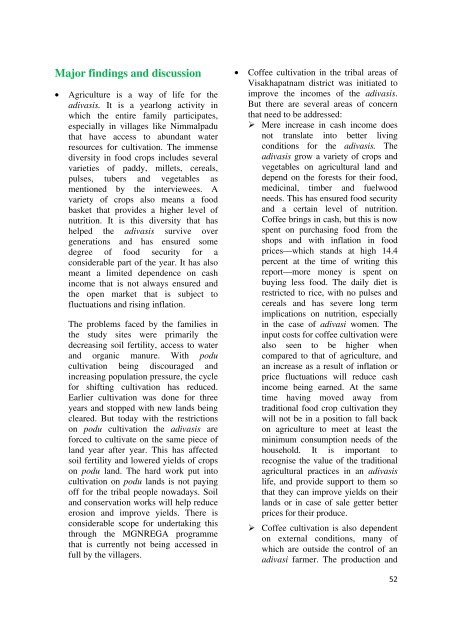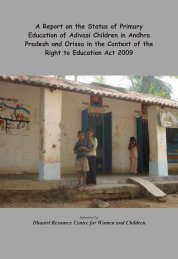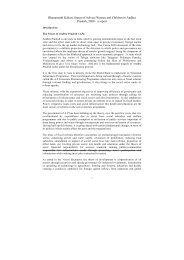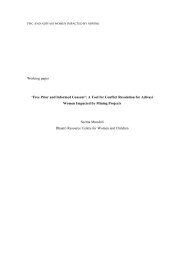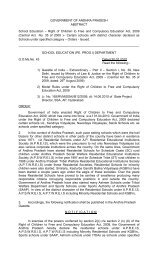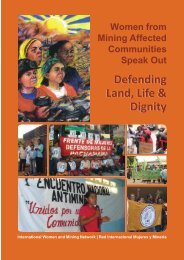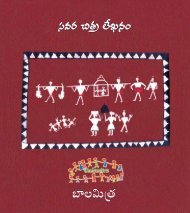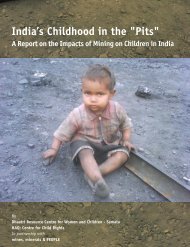Impacts of Government Policies on Sustenance of Tribal ... - Samata
Impacts of Government Policies on Sustenance of Tribal ... - Samata
Impacts of Government Policies on Sustenance of Tribal ... - Samata
Create successful ePaper yourself
Turn your PDF publications into a flip-book with our unique Google optimized e-Paper software.
Major findings and discussi<strong>on</strong>• Agriculture is a way <str<strong>on</strong>g>of</str<strong>on</strong>g> life for theadivasis. It is a yearl<strong>on</strong>g activity inwhich the entire family participates,especially in villages like Nimmalpaduthat have access to abundant waterresources for cultivati<strong>on</strong>. The immensediversity in food crops includes severalvarieties <str<strong>on</strong>g>of</str<strong>on</strong>g> paddy, millets, cereals,pulses, tubers and vegetables asmenti<strong>on</strong>ed by the interviewees. Avariety <str<strong>on</strong>g>of</str<strong>on</strong>g> crops also means a foodbasket that provides a higher level <str<strong>on</strong>g>of</str<strong>on</strong>g>nutriti<strong>on</strong>. It is this diversity that hashelped the adivasis survive overgenerati<strong>on</strong>s and has ensured somedegree <str<strong>on</strong>g>of</str<strong>on</strong>g> food security for ac<strong>on</strong>siderable part <str<strong>on</strong>g>of</str<strong>on</strong>g> the year. It has alsomeant a limited dependence <strong>on</strong> cashincome that is not always ensured andthe open market that is subject t<str<strong>on</strong>g>of</str<strong>on</strong>g>luctuati<strong>on</strong>s and rising inflati<strong>on</strong>.The problems faced by the families inthe study sites were primarily thedecreasing soil fertility, access to waterand organic manure. With poducultivati<strong>on</strong> being discouraged andincreasing populati<strong>on</strong> pressure, the cyclefor shifting cultivati<strong>on</strong> has reduced.Earlier cultivati<strong>on</strong> was d<strong>on</strong>e for threeyears and stopped with new lands beingcleared. But today with the restricti<strong>on</strong>s<strong>on</strong> podu cultivati<strong>on</strong> the adivasis areforced to cultivate <strong>on</strong> the same piece <str<strong>on</strong>g>of</str<strong>on</strong>g>land year after year. This has affectedsoil fertility and lowered yields <str<strong>on</strong>g>of</str<strong>on</strong>g> crops<strong>on</strong> podu land. The hard work put intocultivati<strong>on</strong> <strong>on</strong> podu lands is not paying<str<strong>on</strong>g>of</str<strong>on</strong>g>f for the tribal people nowadays. Soiland c<strong>on</strong>servati<strong>on</strong> works will help reduceerosi<strong>on</strong> and improve yields. There isc<strong>on</strong>siderable scope for undertaking thisthrough the MGNREGA programmethat is currently not being accessed infull by the villagers.• C<str<strong>on</strong>g>of</str<strong>on</strong>g>fee cultivati<strong>on</strong> in the tribal areas <str<strong>on</strong>g>of</str<strong>on</strong>g>Visakhapatnam district was initiated toimprove the incomes <str<strong>on</strong>g>of</str<strong>on</strong>g> the adivasis.But there are several areas <str<strong>on</strong>g>of</str<strong>on</strong>g> c<strong>on</strong>cernthat need to be addressed: Mere increase in cash income doesnot translate into better livingc<strong>on</strong>diti<strong>on</strong>s for the adivasis. Theadivasis grow a variety <str<strong>on</strong>g>of</str<strong>on</strong>g> crops andvegetables <strong>on</strong> agricultural land anddepend <strong>on</strong> the forests for their food,medicinal, timber and fuelwoodneeds. This has ensured food securityand a certain level <str<strong>on</strong>g>of</str<strong>on</strong>g> nutriti<strong>on</strong>.C<str<strong>on</strong>g>of</str<strong>on</strong>g>fee brings in cash, but this is nowspent <strong>on</strong> purchasing food from theshops and with inflati<strong>on</strong> in foodprices—which stands at high 14.4percent at the time <str<strong>on</strong>g>of</str<strong>on</strong>g> writing thisreport—more m<strong>on</strong>ey is spent <strong>on</strong>buying less food. The daily diet isrestricted to rice, with no pulses andcereals and has severe l<strong>on</strong>g termimplicati<strong>on</strong>s <strong>on</strong> nutriti<strong>on</strong>, especiallyin the case <str<strong>on</strong>g>of</str<strong>on</strong>g> adivasi women. Theinput costs for c<str<strong>on</strong>g>of</str<strong>on</strong>g>fee cultivati<strong>on</strong> werealso seen to be higher whencompared to that <str<strong>on</strong>g>of</str<strong>on</strong>g> agriculture, andan increase as a result <str<strong>on</strong>g>of</str<strong>on</strong>g> inflati<strong>on</strong> orprice fluctuati<strong>on</strong>s will reduce cashincome being earned. At the sametime having moved away fromtraditi<strong>on</strong>al food crop cultivati<strong>on</strong> theywill not be in a positi<strong>on</strong> to fall back<strong>on</strong> agriculture to meet at least theminimum c<strong>on</strong>sumpti<strong>on</strong> needs <str<strong>on</strong>g>of</str<strong>on</strong>g> thehousehold. It is important torecognise the value <str<strong>on</strong>g>of</str<strong>on</strong>g> the traditi<strong>on</strong>alagricultural practices in an adivasislife, and provide support to them sothat they can improve yields <strong>on</strong> theirlands or in case <str<strong>on</strong>g>of</str<strong>on</strong>g> sale getter betterprices for their produce. C<str<strong>on</strong>g>of</str<strong>on</strong>g>fee cultivati<strong>on</strong> is also dependent<strong>on</strong> external c<strong>on</strong>diti<strong>on</strong>s, many <str<strong>on</strong>g>of</str<strong>on</strong>g>which are outside the c<strong>on</strong>trol <str<strong>on</strong>g>of</str<strong>on</strong>g> anadivasi farmer. The producti<strong>on</strong> and52


